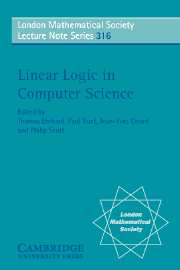9 - Bicategories in Algebra and Linguistics
Published online by Cambridge University Press: 17 May 2010
Summary
Abstract
Reporting on applications of bicategories to algebra and linguistics led me to take a new look at multicategories and polycategories: to replace free monoids by free categories and to introduce a new notation for Gentzen's cuts. This makes it clear that the equations holding in a multior polycategory are just those of the 2-category which contains it. Thus, a polycategory is almost the same as a 2-category whose underlying 1-category is freely generated by a graph, except that the class of 2-cells need not be closed under composition, but only under planar cuts.
Summary of contents
In Section 9.1 we point out that multicategories, slightly generalized, will do for bicategories what they originally did for monoidal categories, i.e. bicategories with one object. At the same time we introduce a new notation for Gentzen's “cut”, to present it as a special case of composition in a 2-category.
In Section 9.2 we look at adjunctions in 2-categories and bicategories, with the aim of studying those bicategories in which each 1-cell has both a left and a right adjoint, namely compact noncommutative *-autonomous categories with several 0-cells.
In Section 9.3 we give a short exposition of some applications of bicategories to linguistics that were developed by Claudia Casadio and the present author. These touch on three deductive systems: the syntactic calculus, classical bilinear logic and compact bilinear logic.
In Section 9.4 we take a new look at polycategories, which are to classical bilinear logic as multicategories are to the syntactic calculus. Equations in a polycategory are explained by viewing the latter as contained in a 2-category.
- Type
- Chapter
- Information
- Linear Logic in Computer Science , pp. 325 - 345Publisher: Cambridge University PressPrint publication year: 2004
- 3
- Cited by

